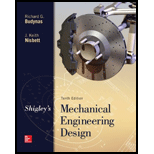
Concept explainers
3–48 and 3–49 The beam shown is loaded in the xy and xz planes.
- (a) Find the y- and z-components of the reactions at the supports.
- (b) Plot the shear-force and bending-moment diagrams for the xy and xz planes. Label the diagrams properly and provide the values at key points.
- (c) Determine the net shear-force and bending-moment at the key points of part (b).
- (d) Determine the maximum tensile bending stress. For Prob. 3–48, use the cross section given in Prob. 3–34, part (a). For Prob. 3–49, use the cross section given in Prob. 3–39, part (b).
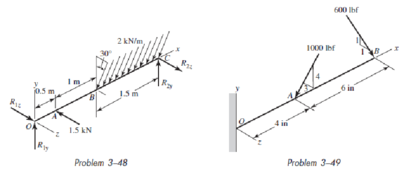
(a)
The
The
Answer to Problem 48P
The
The
Explanation of Solution
The following figure shows the forces acting on the beam along x-z plane.
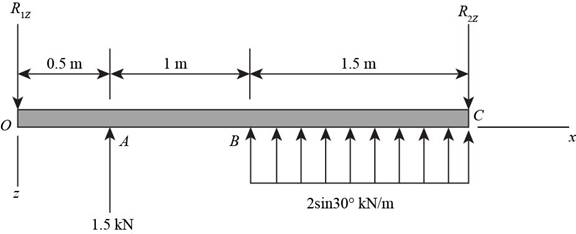
Figure-(1)
Write the equilibrium equation of force applied on the beam in
Write the bending moment at the support
The following figure shows the forces acting on the beam along x-y plane.
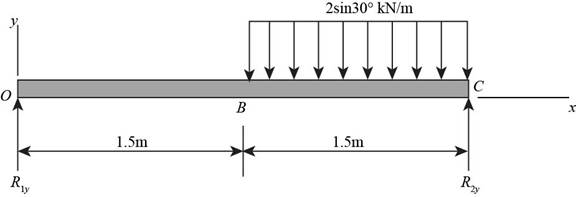
Figure-(2)
Write the equilibrium equation of force applied on the beam in
Write the bending moment at the support
Conclusion:
From Equation (II),
Substitute
Thus, the
Simplify Equation (IV).
Substitute
Thus, the
(b)
The shear force and bending moment diagram of the beam.
Explanation of Solution
Write the expression for the moment at point A.
Write the expression for the moment at point B.
Write the equation for the shear force.
Write the expression for the maximum bending moment.
Write the expression for the bending moment at B.
Write the equation for the shear force.
Write the expression for the maximum bending moment.
Conclusion:
Substitute
Substitute
The maximum bending moment occur at
Substitute
Substitute
The following figure shows the shear force and bending moment diagram of the beam along x-z plane.
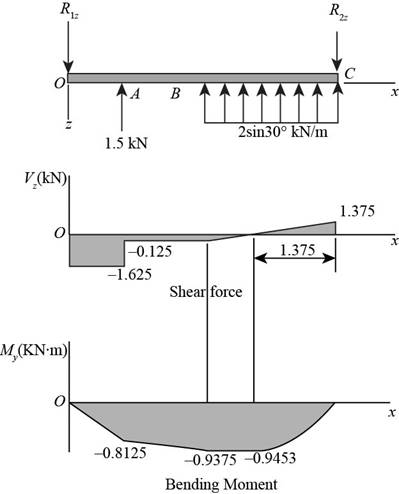
Figure-(3)
Substitute
The maximum bending moment occur at
Substitute
Substitute
The following figure shows the shear force and bending moment diagram of the beam along x-y plane.
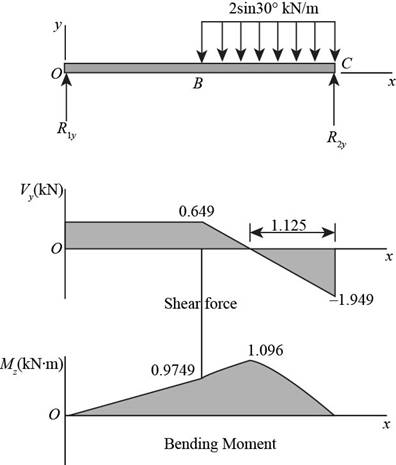
Figure-(4)
(c)
The net bending moment at
The net shear force at
The net bending moment at
The net shear force at
The net bending moment at
The net shear force at
The net bending moment at
The net shear force at
Answer to Problem 48P
The net bending moment at
The net shear force at
The net bending moment at
The net shear force at
The net bending moment at
The net shear force at
The net bending moment at
The net shear force at
Explanation of Solution
Write the expression for the net shear force on the beam.
Write the expression for the net bending moment on the beam.
Conclusion:
The following table shows the magnitudes of bending moment and shear force along x-y and x-z plane from the shear force and bending moment diagram.
At
Substitute
Thus, the net shear force at
Substitute
Thus, the net bending moment at
At
Substitute
Thus, the net shear force at
Substitute
Thus, the net bending moment at
At
Substitute
Thus, the net shear force at
Substitute
Thus, the net bending moment at
At
Substitute
Thus, the net shear force at
Substitute
Thus, the net bending moment at
(d)
The maximum tensile bending stress on the beam.
Answer to Problem 48P
The maximum tensile bending stress on the beam is
Explanation of Solution
The following diagram shows the cross-section of the beam.
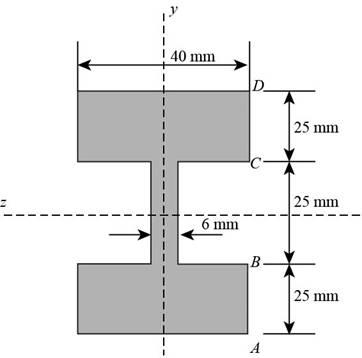
Figure-(5)
Write the expression for the second moment of area of the section about z-axis.
Here, the second moment area of the area
Write the moment of inertia of the rectangular section.
Here total height of the section is
Write the expression for the moment of inertia about y-axis.
Here, the height of the flange is
Write the expression for maximum tensile bending stress.
Conclusion:
Substitute
Substitute
Substitute
Substitute
Substitute
Thus, the maximum tensile bending stress on the beam is
Want to see more full solutions like this?
Chapter 3 Solutions
Shigley's Mechanical Engineering Design (McGraw-Hill Series in Mechanical Engineering)
- 1) In each of the following scenarios, based on the plane of impact (shown with an (n, t)) and the motion of mass 1, draw the direction of motion of mass 2 after the impact. Note that in all scenarios, mass 2 is initially at rest. What can you say about the nature of the motion of mass 2 regardless of the scenario? m1 15 <+ m2 2) y "L χ m1 m2 m1 בז m2 Farrow_forward8. In the following check to see if the set S is a vector subspace of the corresponding Rn. If it is not, explain why not. If it is, then find a basis and the dimension. X1 (a) S = X2 {[2], n ≤ n } c X1 X2 CR² X1 (b) S X2 = X3 X4 x1 + x2 x3 = 0arrow_forward2) Suppose that two unequal masses m₁ and m₂ are moving with initial velocities V₁ and V₂, respectively. The masses hit each other and have a coefficient of restitution e. After the impact, mass 1 and 2 head to their respective gaps at angles a and ẞ, respectively. Derive expressions for each of the angles in terms of the initial velocities and the coefficient of restitution. m1 m2 8 m1 ↑ บา m2 ñ Вarrow_forward
- The fallowing question is from a reeds book on applied heat i am studying. Although the answer is provided, im struggling to understand the whole answer and the formulas and the steps theyre using. Also where some ov the values such as Hg and Hf come from in part i for example. Please explain step per step in detail thanks In an NH, refrigerator, the ammonia leaves the evaporatorand enters the cornpressor as dry saturated vapour at 2.68 bar,it leaves the compressor and enters the condenser at 8.57 bar with50" of superheat. it is condensed at constant pressure and leavesthe condenser as saturated liquid. If the rate of flow of the refrigerantthrough the circuit is 0.45 kglmin calculate (i) the compressorpower, (ii) the heat rejected to the condenser cooling water in kJ/s,an (iii) the refrigerating effect in kJ/s. From tables page 12, NH,:2.68 bar, hg= 1430.58.57 bar, hf = 275.1 h supht 50" = 1597.2Mass flow of refrigerant--- - - 0.0075 kgls 60Enthalpy gain per kg of refrigerant in…arrow_forwardstate the formulas for calculating work done by gasarrow_forwardExercises Find the solution of the following Differential Equations 1) y" + y = 3x² 3) "+2y+3y=27x 5) y"+y=6sin(x) 7) y"+4y+4y = 18 cosh(x) 9) (4)-5y"+4y = 10 cos(x) 11) y"+y=x²+x 13) y"-2y+y=e* 15) y+2y"-y'-2y=1-4x³ 2) y"+2y' + y = x² 4) "+y=-30 sin(4x) 6) y"+4y+3y=sin(x)+2 cos(x) 8) y"-2y+2y= 2e* cos(x) 10) y+y-2y=3e* 12) y"-y=e* 14) y"+y+y=x+4x³ +12x² 16) y"-2y+2y=2e* cos(x)arrow_forward
- The state of stress at a point is σ = -4.00 kpsi, σy = 16.00 kpsi, σ = -14.00 kpsi, Try = 11.00 kpsi, Tyz = 8.000 kpsi, and T = -14.00 kpsi. Determine the principal stresses. The principal normal stress σ₁ is determined to be [ The principal normal stress σ2 is determined to be [ The principal normal stress σ3 is determined to be kpsi. kpsi. The principal shear stress 71/2 is determined to be [ The principal shear stress 7½ is determined to be [ The principal shear stress T₁/, is determined to be [ kpsi. kpsi. kpsi. kpsi.arrow_forwardRepeat Problem 28, except using a shaft that is rotatingand transmitting a torque of 150 N * m from the left bearing to the middle of the shaft. Also, there is a profile keyseat at the middle under the load. (I want to understand this problem)arrow_forwardProb 2. The material distorts into the dashed position shown. Determine the average normal strains &x, Ey and the shear strain Yxy at A, and the average normal strain along line BE. 50 mm B 200 mm 15 mm 30 mm D ΕΙ 50 mm x A 150 mm Farrow_forward
- Prob 3. The triangular plate is fixed at its base, and its apex A is given a horizontal displacement of 5 mm. Determine the shear strain, Yxy, at A. Prob 4. The triangular plate is fixed at its base, and its apex A is given a horizontal displacement of 5 mm. Determine the average normal strain & along the x axis. Prob 5. The triangular plate is fixed at its base, and its apex A is given a horizontal displacement of 5 mm. Determine the average normal strain &x along the x' axis. x' 45° 800 mm 45° 45% 800 mm 5 mmarrow_forwardAn airplane lands on the straight runaway, originally travelling at 110 ft/s when s = 0. If it is subjected to the decelerations shown, determine the time t' needed to stop the plane and construct the s -t graph for the motion. draw a graph and show all work step by steparrow_forwarddny dn-1y dn-1u dn-24 +a1 + + Any = bi +b₂- + +bnu. dtn dtn-1 dtn-1 dtn-2 a) Let be a root of the characteristic equation 1 sn+a1sn- + +an = : 0. Show that if u(t) = 0, the differential equation has the solution y(t) = e\t. b) Let к be a zero of the polynomial b(s) = b₁s-1+b2sn−2+ Show that if the input is u(t) equation that is identically zero. = .. +bn. ekt, then there is a solution to the differentialarrow_forward
 Mechanics of Materials (MindTap Course List)Mechanical EngineeringISBN:9781337093347Author:Barry J. Goodno, James M. GerePublisher:Cengage Learning
Mechanics of Materials (MindTap Course List)Mechanical EngineeringISBN:9781337093347Author:Barry J. Goodno, James M. GerePublisher:Cengage Learning
